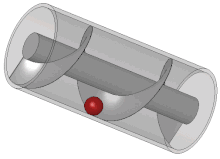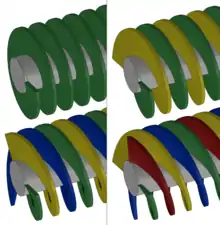Screw turbine
The screw turbine or Archimedean turbine is a water turbine which uses the principle of the Archimedean screw to convert the potential energy of water on an upstream level into work. It may be compared to the water wheel. The turbine consists of a rotor in the shape of an Archimedean screw which rotates in a semicircular trough. Water flows into the turbine and its weight presses down onto the blades of the turbine, which in turn forces the turbine to turn. Water flows freely off the end of the turbine into the river. The upper end of the screw is connected to a generator through a gearbox.



History

The Archimedean screw is an ancient invention, attributed to Archimedes of Syracuse (287–212 BC.), and commonly used to raise water from a watercourse for irrigation purposes. In 1819 the French engineer Claude Louis Marie Henri Navier (1785–1836) suggested using the Archimedean screw as a type of water wheel. In 1916 William Moerscher applied for a U.S. patent on the hydrodynamic screw turbine.[1]
Application

The Archimedean screw turbine is applied on rivers with a relatively low head (from 0.1 m to 10 m)[2] and on low flows (0.01 m³/s up to around 10 m³/s on one turbine). Due to the construction and slow movement of the blades of the turbine, the turbine is considered to be friendly to aquatic wildlife. It is often labelled as "fishfriendly". The Archimedean turbine may be used in situations where there is a stipulation for the preservation and care of the environment and wildlife.
Examples
In the UK
- Devon, Totnes 320 kW , Commissioned December 2015[3]
- Romney, Berkshire, 270 kW, Installed to provide a renewable source of energy to Windsor Castle, Commissioned July 2013[4]
- Bealey’s Weir, Radcliffe, 100 kW, Commissioned May 2012[5]
- Mapledurham, River Thames, UK’s largest flow capacity (8 m³/s) single screw, 99 kW.[6]
- Buckfast, River Dart, screw turbine and fishpass, 84 kW[6]
- UK’s first community owned hydro scheme, and fishpass, 63 kW at New Mills.[6]
- UK’s first grid connected screw turbine, 50 kW at River Dart Country Park.[6]
- Bainbridge, community owned screw turbine, 37 kW[6]
- Tipton, River Otter, 30 kW[6]
- Rochdale, screw turbine and fishpass, 20 kW[6]
- Cragside, the birthplace of hydroelectricity, 12 kW[7]
In the United States
- Hanover Pond on the Quinnipiac River in Meriden, Connecticut, 105 kW (or 920,000 kWh/year), grid connected, commissioned April, 2017; the first Screw Turbine installation in the US.[8][9]
In Canada
- The first Archimedes screw turbine was installed in Canada in 2013 near Waterford, Ontario.[2]
Literature
- P. J. Kantert: Manual for Archimedean Screw Pump, Hirthammer Verlag 2008, ISBN 978-3-88721-896-6
- P. J. Kantert: Praxishandbuch Schneckenpumpe. Hirthammer Verlag 2008, ISBN 978-3-88721-202-5
- William Moerscher - Patent US1434138
- K. Brada, K.-A. Radlik - Water Screw Motor to Micro Power Plant - First Experiences of Construction and Operation (1998)
- K. Brada - Micro Power Plant with Water Screw Motor (1995)
- K. Brada, K.-A. Radlik - Water Power Screw - Characteristic and Use (1996)
- K. Brada, K.-A. Radlik, (1996). Water screw motor for micropower plant. 6th Intl. Symp. Heat exchange and renewable energy sources, 43–52, W. Nowak, ed. Wydaw Politechniki Szczecińskiej, Szczecin, Poland.
See also
References
- William Moerscher, Water-power system, U.S. Patent 1,434,138, granted Oct 31, 1922.
- YoosefDoost, Arash; Lubitz, William David (2020). "Archimedes Screw Turbines: A Sustainable Development Solution for Green and Renewable Energy Generation—A Review of Potential and Design Procedures". Sustainability. 12 (18): 7352. doi:10.3390/su12187352.
- "Totnes | MannPower Consulting". www.mannpower-hydro.co.uk. Retrieved 2016-08-05.
- "Romney | MannPower Consulting". www.mannpower-hydro.co.uk. Retrieved 2016-08-05.
- "Bealeys Weir | MannPower Consulting". www.mannpower-hydro.co.uk. Retrieved 2016-08-05.
- "Hydro Power Case Studies, Micro-Hydro Case Studies - Western Renewable Energy". www.westernrenew.co.uk. Retrieved 2016-08-05.
- "Hydropower returns to Cragside". National Trust. Retrieved 2016-08-09.
- Andrew Ragall, Ancient technology in Meriden's Hannover Pond dam begins generating electricity, Meriden Record Journal, April 27, 2017.
- New England Hydropower Energizes First Archimedes Screw Turbine in U.S., PR Newswire, April 27, 2017.
External links
| Wikimedia Commons has media related to Archimedes' screw power plants. |
- spaansbabcock.com/products/screw-turbine Hydropower screw
- Information on one of the manufacturers
- (in Polish) The first screw turbine in Poland